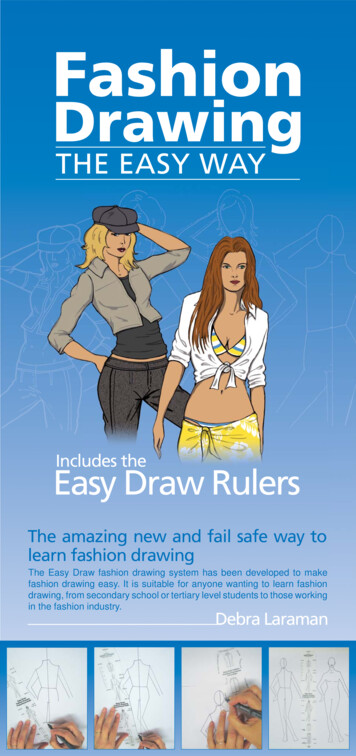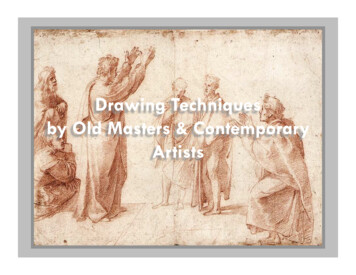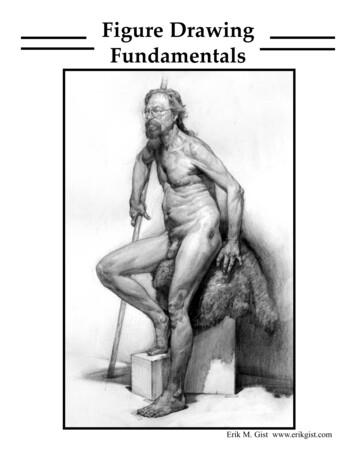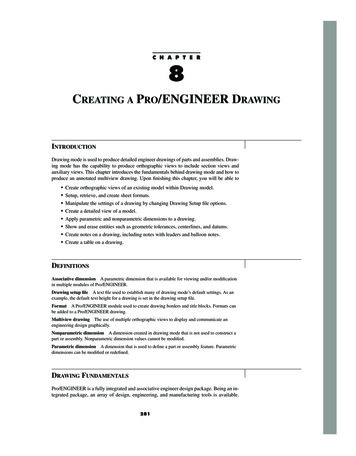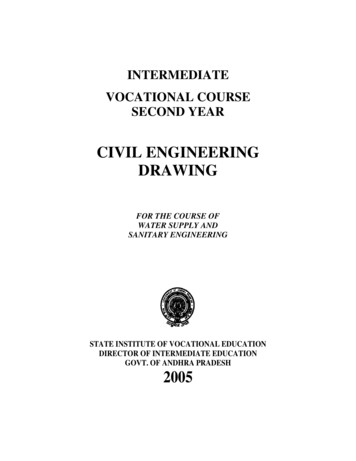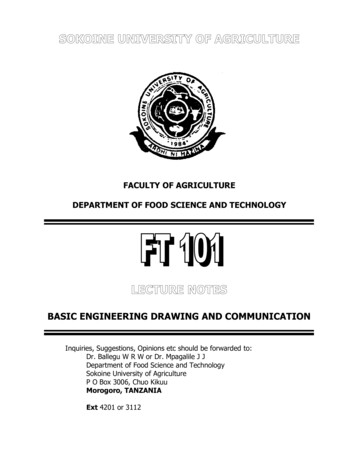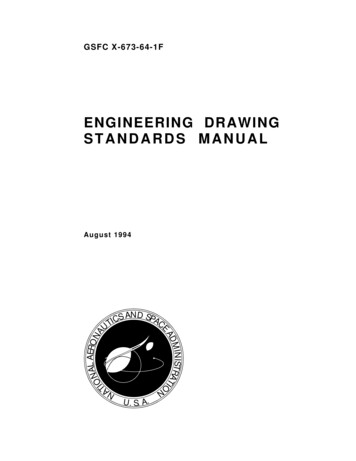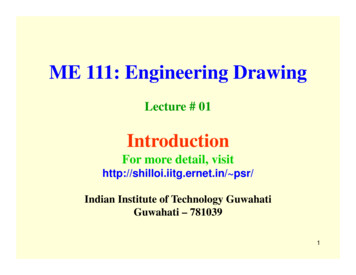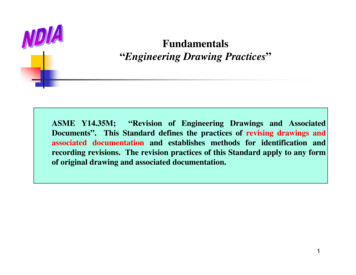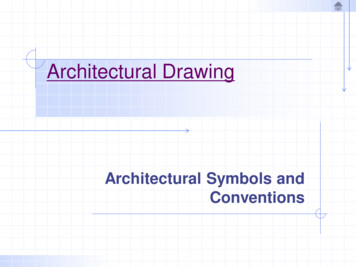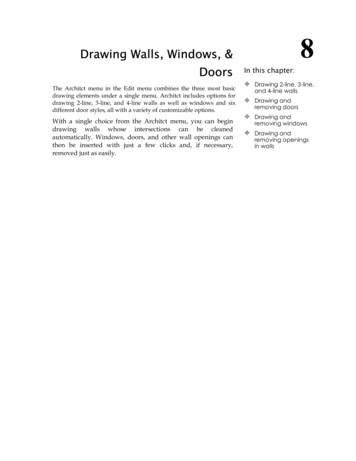
Transcription
Pencil DrawingA Beginner's Guide
LEGAL NOTICEThe Publisher has strived to be as accurate and complete aspossible in the creation of this report, notwithstandingthe fact that he does not warrant or represent at any timethat the contents within are accurate due to the rapidlychanging nature of the Internet.While all attempts have been made to verify informationprovided in this publication, the Publisher assumes noresponsibility for errors, omissions, or contraryinterpretation of the subject matter herein. Any perceivedslights of specific persons, peoples, or organizations areunintentional.In practical advice books, like anything else in life,there are no guarantees of income made. Readers arecautioned to reply on their own judgment about theirindividual circumstances to act accordingly.This book is not intended for use as a source of legal,business, accounting or financial advice. All readers areadvised to seek services of competent professionals inlegal, business, accounting, and finance field.
Table of ContentsINTRODUCTION .06What it takes to be a Good ArtistAdvantages and Disadvantages of Pencil DrawingBRIEF HISTORY OF PENCIL DRAWING .09Famous Pencil Drawing Artists and their WorksThe Story of the PencilGETTING STARTED 11Materials and Tools: Choosing the Right Kind and QualityPencilEraserDrawing PadDrawing boardPaper Stumps or Cone BlendersPencil SharpenerRulerLEARNING THE BASICS IN DRAWING AND SKETCHING .16How to Hold the Pencil: The Different Pencil GripsTripod GripExtended GripUnderhand GripOverhand GripHow to Draw LinesFlat LinesAccent LinesContour LinesScumble/ScribblingCross Hatch LineSmudgePointillismBasic Perspectives in Drawing . . .23An Introduction on PerspectivesLinear perspectiveZero Point Perspective
One Point perspectiveTwo Point PerspectiveThree-Point perspectiveIsometric PerspectiveAtmospheric PerspectiveBasic Drawing Shapes . . .28Basic Elements of Light, Shadows, and Shading . .30Light, Shadows and Shadow BoxConstructing a Simple Shadow boxKinds and Quality of LightHard LightSoft lightBasic Elements of Shading . .33The Highlight or Full LightThe Cast ShadowThe HalftoneThe Reflected LightThe Shadow EdgeDifferent Shading TechniquesRegular ShadingIrregular ShadingCircular ShadingDirectional ShadingHow to Add Tones and ValuesSome Tips on Tones and ValuesSome Examples on ShadingFINISHING TOUCHES .37Erasing and DustingMIXED MEDIA APPLICATIONS . .41How color pencil can bring wonders in your black and white worldUsing Watercolor Pencils and Oil PencilsWatercolor PencilsOil Colored PencilsDrawing with Pencils in Oil Painting .47Pen and Ink DrawingHow Pencil Drawing Can Help in Your Wall PaintingCartoon Drawing
Tips on How to Draw FasterCONCLUSION . .57
INTRODUCTIONAnyone can draw but not everyone can make good drawings. Pencil drawing is a skillthat needs a good foundation on theories because pencil drawing is a blend of theoryand proper execution of these theories.Practice makes drawing perfect but foundation on the theories and techniques indrawing paves the way for better drawings.This ebook mainly targets beginners in pencil drawing and those who wish to enhancetheir pencil drawing skills through other techniques and insights that one may find here.Anyone may use this ebook to hone his or her drawing skills with the end goal ofbecoming a better pencil-drawing artist through this small tribute.This ebook, written in non-technical language, seeks to promote better understanding.It covers the basics of pencil drawing, providing for a good foundation for pencil drawingand some practical tips.This ebook contains articles on pencil drawing, and it shows how to draw step-by-stepcommon objects such as people, cars and animals.Since drawing is visual, chapters are short providing for more illustrations andapplication of drawing theories.The maker of this ebook hopes to inspire individuals to pursue the art of pencil drawingand unleash their artistic mind.
What it takes to be a Good ArtistI’m not anartist I just looklike one!Artists are made not born. Unlike medicine or law that onehas to have proper education to be equipped with thedegree of knowledge, most of the artists around todayare self-taught artists. Going to a formal art school is not apre-requisite before one becomes an artist. Unless if onedesires to be a commercial artist or one that works forcompanies or newspapers.The artist’s journey starts with the desire to express themselves through drawing andart. In fact, they can express themselves better than they do with words. Drawing comesnaturally for them.Some could express themselves through cartoons or comicstrips while others make abstract paintings. Just becausedrawing comes naturally for them, it doesn’t mean that theydealt away with the basics of drawing. They still learned thebasics of drawing, but they adopted their own style indrawing.Having technical skills in drawing is good but drawing shouldbe more on self expression. In drawing, there is no correct orwrong style because drawing is self expression. It is up to theviewer to appreciate that particular self expression or not.These artists were curious and discerning about the worldaround them. They have an eye for details and how objectsand scenery were composed by nature. Having the drive andpersistence to imitate nature and give life to their vision,artists constantly practice to perfect their craft. Deciding tobecome an artist is an easy decision but becoming one is notquite as such.
Advantages and Disadvantages of Pencil DrawingThe advantage of using a pencil when drawing as opposed to using a pen is that you caneasily erase mistakes when you use a pencil for drawing. Artists can make mistakes andnot have to start all over again. Erasing is not just for mistakes.Pencil drawing is a process, artists start drawing by making light outlines that help themcreate a drawing.You can also erase later on the outlines and people will hardly notice that the drawingcame from simple lines. Using pencils in drawing is inexpensive because you will justneed a pencil and paper to create a basic drawing.Pencils and papers are easy to carry around that you do not have to confine yourselvesto your studio when making a drawing.Pencils are affordable and sold in most stores. You do not have to worry about thepencil drying up or reaching its expiry date. It can be stored anywhere and maintaining itis hassle free.Unlike using paints and other media that give off nasty fumes, pencils are odorless.Manufacturers made pencils versatile depending on the artist’s needs, one get veryblack to light gray. Pencils can also be very soft, which makes it easy for shading or hard,which makes it perfect for fine details.Pencil drawings have atendency to smudge if youtouch or rub them. Those oncefine details will look like asmear. It is important to keephands away from the paperwhile drawing or cover yourdrawing with another piece ofpaper while trying to completethe work.Once the drawing is completed,seal the drawing to preventfrom smudging. Sealing is alsoimportant because of the temporary nature of pencil drawings, and you can use asealing or a fixative spray for this. Others use hair sprays that are perfume free. Artistslightly spray on these on their work.
BRIEF HISTORY OF PENCIL DRAWINGFamous Pencil Drawing Artists and their WorksUsing a pencil has many advantages, one of which is that it is very easy to erase one’smistakes. There are famous people in the world who preferred to use pencils.Vincent van Gogh, a notable artist used Faber-Castell pencils. According to him, thesepencils were superior. He liked its blackness and found it easy to use.Pablo Picasso used a pencil with his works of art. Jean Auguste- Ingres made the Portraitof Mme Guillaume Guillon Lethiere. John Constable used a pencil and a sepia wash in hisTrees and a Stretch of Water on the Stour.These works are in different famous art galleries and museums around the world.
The Story of the PencilLong time ago, Greek artists used to draw on papyrus using a metal stylus. In CumbriaEngland, there were large deposits of graphite. Locals used the graphite for markingsheep. Although graphite was solid, it was soft that it needed a case before you can useit easily.Early civilization used sheepskin to wrap the graphite. England continued to producepencils while in 1662; Nuremberg Germany attempted to manufacture pencils using amixture of graphite, antimony and sulphur. Italy was the first to use wooden holders.They carved two wooden halvesand inserted the graphite stick.The wooden halves were thenglued together.Many years later, Ebenezer Woodin America automated the processof pencil making. Joseph Dixonfound a way to mass producepencils. Hymen Lipman attachedthe eraser to the pencil.Today, annual production of apencil is at around 14 billionpencils.These pencils may be round-shaped,triangular or hexagonal. There are evenbendable pencils. Pencil variations includemechanical pencils, which has amechanism that pushes the lead throughthe end. A Quadra chromic pencil has fourcolors at its tip.
GETTING STARTEDMaterials and Tools:Choosing the Right Kind and QualityThe age old debate aboutthe artist’s skills’ versushigh quality materials isstill applicable even untiltoday. Quality of tools andmaterials used affects theartwork.One cannot aspire to ownand use top quality artmaterials, especially whenone is just beginning. Thebest attitude towards theproblem of not having enough materials is this:It is more miserable to have no skills in art but have the best materials and toolsavailable than to have mediocre materials but have excellent artistic skills.
PencilThe pencil is an instrument commonly used to drawing. A stick ofgraphite or a mixture is encased in wood. At one end of the pencil isan eraser. There are many kinds of pencils.Manufacturers use “H” for hardness, “B” for blackness, “F” for a finepoint. Pencils can be very dark or very light. Artists may needdifferent pencils for making grays and blacks.Pencils can also be hard or soft. Hard pencils are needed byengineers because it gives them better control in making preciselines. For users who cannot decide which one to use, the safest isHB. Some artists use the non photo blue pencil. It is a pencil usedmainly for outlining. It comes in a very light blue color, a shade thatcameras cannot catch. Artists can save time with this pencil becausethey do not have to erase it.Mechanical pencils are available in .5mm or .7mm lead. Mechanicalor automatic pencils do away with the need to sharpen the pencils.The downside of using mechanical pencils is the lack of variety ofgrades.
EraserIt is impossible not to make a mistake while drawing. More often than not, oneconsumes the eraser at the tip of the pencil before the pencil. An eraser is an essentialtool in an artist’s toolbox.Erasers may come frompulverized pumice. Do not usethis type of eraser to heavily, orit will damage the paper. Aftererasing, brush away the residuethat this type or eraser willleave.Soft vinyl erasers are softer andcause lesser damage on paper than erasers made from pumice. This eraser is good forprecision erasing and erasing light marks.The kneaded eraser reminds people of chewing gum. Unlike the eraser made frompumice, this type of eraser does not leave any residue. With the use of your fingers, youcan shape kneaded erasers making it easy to erase little details. This eraser is difficult touse in large areas.An art gum eraser is another type of eraser that is widely used among artists. Unlike thekneaded eraser, removing large areas is easier with this eraser. The downside of using agum eraser is that it is not precise in erasing fine mistakes.
Drawing PadA drawing pad is also knownas a sketch pad. It is made upwhite paper bounded in onebook. It can be used fordrawing and scrap booking.Drawing pads come indifferent sizes. It’s alwaysimportant to have a sketchpad to contain all yourdrawings.Practice bringing a smallsketch pad around, so thatyou can easily draw what captures your attention. Leonardo da Vinci always had asketch pad or a notebook with him. It allowed him to draw everyday objects andmovement with ease.Drawing boardA drawing board can be used for several purposes. It can be used for writing, readinglarge documents and making large sketches. This equipment is highly optional, unlessyou aim to draw in large scale.Paper Stumps or Cone BlendersBlending is a big part in drawing. Do not use fingers because fingers leave oil on thepaper which can be visible in certain light. Artists use blending stumps or paper stumpsto blend large areas.
Pencil SharpenerAnother essential tool that should be found in the artist’stoolbox is the pencil sharpener. This is a device that shavesthe end of the pencil thereby sharpening its point.Some artists may use sandpaper block and use a knife forthe wooden part of the pencil. A large part of pencil drawingdepends on keeping a sharp pencil.RulerA ruler is used in technical drawing,engineering and geometry. Rulers helpyou make straight lines or make precisemeasurements. On the topic ofperspective, the ruler will be frequentlyused.
LEARNING THE BASICS IN DRAWING ANDSKETCHINGHow to Hold the Pencil? - The Different Pencil GripsTripod GripThe tripod grip is the most common way of holding apen or a pencil. Although it might be the commonway of holding a pencil, many people are not doingthe tripod grip correctly. The correct way to make atripod grip is to position the pencil applying equalpressure between the side of the middle finger, thetip of the index finger and the thumb.Do not grip the pencil t
Pencil drawing is a process, artists start drawing by making light outlines that help them create a drawing. You can also erase later on the outlines and people will hardly notice that the drawing came from simple lines. Using pencils in drawing is inexpensive because you will just need a pencil and paper to create a basic drawing.

